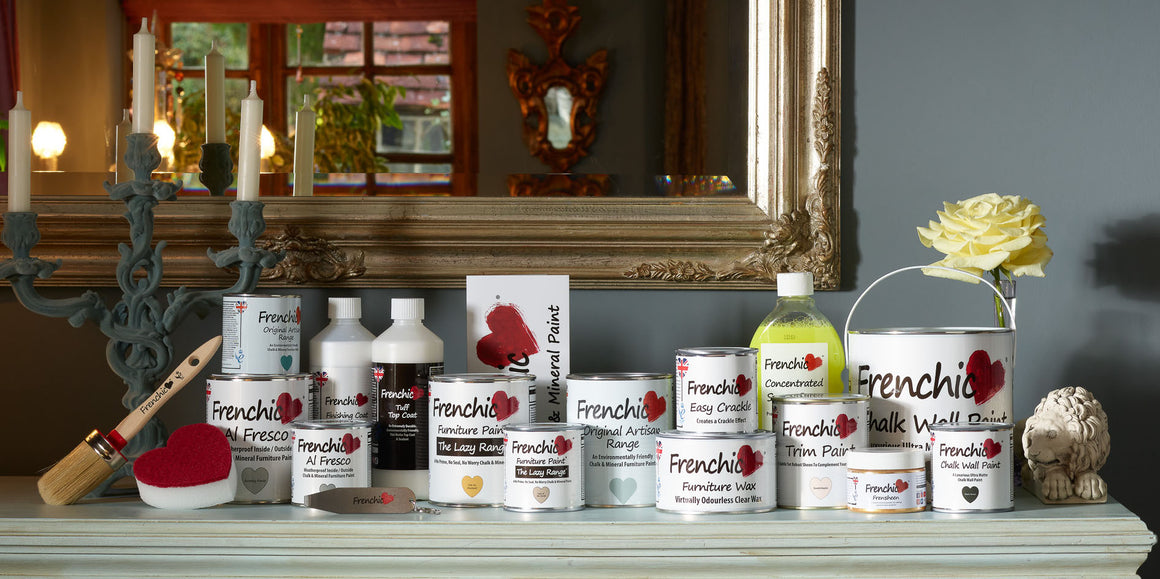
Beam Renovation: How to Transform Your Ceiling Beams
Beam Renovation: How to Transform Your Ceiling Beams
There’s nothing more charming than ceiling beams, but how do you achieve an authentic oak effect if they've already been painted? Luckily, you don't have to replace the timber or go through the pain, mess and expense of stripping them. All you need for beam renovation is high-quality paint from the Lazy Range and Browning Wax to achieve, what has become known as the Frenchic Beam Hack!
Whether you're wondering how to transform artificial beams that box in RSJs and pipework, or have painted, traditional solid wood beams, our talented brand ambassador Craig Phillips covers everything you need to know about refreshing your canopy space.
Solid wood beams usually have plenty of surface texture and character which makes the transformation easy and very effective. But in this guide, we'll also reveal some easy-to-follow methods of turning plain, box beams, into gorgeous architectural features as well.
First of all, let’s cover some of the most frequently asked questions…
What Can You Do With Old Beams?
Old beams can be:
- Boxed off with plywood if they don’t fit with your interior
- Removed and replaced with a hidden steel beam if they’re still load bearing
- Renovated using our simple guide – which we definitely recommend!
How Do You Renovate Old Beams?
How you renovate old beams depends on the type of beam in question. Traditional wooden beams simply need to be scrubbed thoroughly then waxed or painted. Smooth, artificial beams will need a little more work to add texture, as covered in this post.
What Can I Do Instead of Sandblasting Beams?
Instead of sandblasting, which can be highly disruptive, we recommend a thorough scrub using sugar soap and warm water. You’ll still remove dirt and dust as required, providing a suitable surface for your new coating of paint or wax.
How Do You Update Wood Beams?
If you want to give wood beams a more up-to-date look, you could try staining them instead of painting. Alternatively, you can paint them in a colour which contrasts the ceiling – both options are covered in our guide.
Beam Renovation Guide
What You’ll Need
- Sugar Soap
- Cleaning products, including sponges and bowls
- Suitable paint (Craig uses Crème De La Crèmefrom the self-priming Lazy Range)
- Frenchic Browning Wax
- Paint brushand something to apply the wax (Craig uses a wax brush)
- If you have a box beam – sharp tools, including a bradawl, hammer, chisel, saw, block plane and collection of nails
Preparing Your Beams
The secret to any successful DIY project is preparation. Before brandishing your brushes, check whether your beams are in a suitable condition to paint.
In the video, Craig explains how to transform two types of beams – solid timber and hollow softwood. Both require different approaches. The solid timber structure already has a visible grain, whereas the artificial beam has minimal texture. As such, you'll need to distress the wood before painting and waxing.
Preparing Solid Wood Beams
Start by mixing concentrated sugar soap with warm water. Then give the beam a thorough scrub to remove dirt and dust, paying special attention to the deeper grooves. When cleaning the beam in situ, use masking tape to protect the surrounding plasterwork. Rinse away the soapy residue and leave the surface to dry before applying your paint and wax.
Preparing Artificial Beams
Preparing artificial beams more work because, for the best way to make the beam look like a real beam, the smooth surface will need added texture before painting and waxing. However, the first step is the same as above. Mix concentrated sugar soap with warm water and scrub the surfaces.
Now it's time to distress the smooth exterior with various tools, including handsaws, chisels and hammers. Contrary to what we usually tell you in these guides, the more scrapes and scuffs, the better! Craig starts with the beam's edges. He removes the sharp lines and corners with a block plane, giving the structure a more natural curved shape.
Then he uses a bradawl to accentuate the grain effect. This step is crucial. Otherwise, the chalk paint will disguise the subtle grooves and recesses. He uses the sharp edge to score the timber, following the lines of the knots and splits that are already present.
Next, chisel away bits of wood from around the edges, strike the surface with the claw edge of a hammer and run your saw horizontally across the beam. Finally, use a wooden block with nails to create deep holes – it mimics natural aged wood and creates a lived-in feel.
Painting Solid Wood Beams
Preparation finished, Craig cracks open the Crème De La Crème paint from the Lazy Range. The thick and creamy consistency is self-priming and easy to apply. The beam's craggy surface also lends itself to a lighter paint and darker furniture wax combination.
You can apply the paint straight from the can but stir beforehand. The first coat will be touch dry within one hour and ready for a second coat within two hours, if you want to apply one.
Painting Artificial Beams
Thanks to your hard work, your artificial beam should now have all the character of traditional timber. Before painting, we suggest recleaning the surfaces to remove excess dust and splinters.
Load your paintbrush and apply the paint in the direction the woodgrain would run – usually lengthways along the beam, working the colour into the newly created tracks and troughs. Leave the first coat to dry for around four hours before applying your second coat in the same manner.
When painting a flat surface, you might normally want a smooth, plaster-like finish. However, beam renovation is one of the times you don't. Craig suggests overworking the paint to emphasise the texture. He overloads his brush, covers the timber and waits four to five minutes. Then he drags the brush over the surface again. Leave the second coat to dry for around four hours before tackling the furniture wax.
Applying Wax To Solid Wood Beams
As Craig mentions, applying Browning Wax is fuss-free and simple to do. Grab a stiff brush – a Frenchic Large Wax Brush is great – load plenty of wax and apply liberally. You don't have to be gentle or neat. Instead, firmly press the bristles into every nook and cranny for full coverage.
If you spot black dots on the beam where the wax is gathering, it's probably down to dry wood rot or woodworm. However, don't be alarmed – it adds to the attractive aged aesthetic. You can add to the effect by using an old piece of timber with nails attached. Hammer the beam along the top to penetrate the surface, then apply more wax.
Leave the beam for 10 to 20 minutes to allow the wax to penetrate the paint and timber. At this point, you could use a soft sponge to experiment with the final look. Dabbing the surface retains the colour, while lightly buffing the wax lifts the tone.
Applying Wax To Artificial Beams
Grab your brush, load the bristles and spread the wax across the beam. Remember, you don't have to be precious. Use plenty of product, so it gathers in and accentuates the scars you made earlier. If you notice any marks where you stop and start with the brush, gently feather them out without adding or removing wax.
If, after leaving it to dry, the wax is too dry (like Craig finds) you can simple apply a little more wax. This will allow you to move the wax around again to help you get an even finish.
Light Oak Vs Dark Oak
Whether you choose a light or dark oak effect depends on personal preference – why not experiment to see which is best for you? In the video, Craig demonstrates the finished pieces for reference. Head to 5.50 to see the contrast for yourself.
The black beams were prepared and painted the same way, the only distinction being that the solid wood beam had one coat of paint, whereas the artificial structure had two. Craig used one coat of wax on both.
So, how did he achieve such different outcomes? With the lighter beam, he waited 10 to 15 minutes after waxing to lightly wipe the surface with a sponge. On the other hand, he didn't touch the darker beam, which let more wax remain and penetrate the wood.
What’s The Best Paint For Beam Renovation?
If you're hoping to restore your drab ceiling beams, you can't go wrong with premium paint from the Lazy Range. The award-winning formula is ideal for breathing new life into interiors. Best of all, it’s self-priming, self-levelling and self-sealing for unbeatable convenience.
While Craig used Crème De La Crème, there are countless other on-trend colours to browse – plus four shades of furniture wax to achieve the look of your dreams. Our post on how to paint wooden beams on the ceiling has plenty of other ideas to inspire you using these products!
































